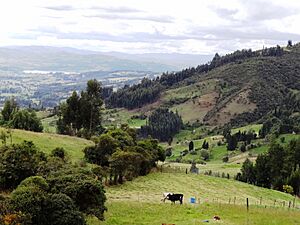Tundama facts for kids
Quick facts for kids Tundama |
|
|---|---|
| cacique | |
| Reign | until 1539 |
| Predecessor | unknown |
| Successor | Don Juan |
| Born | 15th century Muisca Confederation |
| Died | end of December 1539 Duitama, New Kingdom of Granada |
Tundama (also known as Saymoso) was an important leader, called a cacique, of the Muisca people. He lived in what is now Colombia during the 15th and 16th centuries. Tundama was one of the last Muisca rulers to resist the Spanish conquistadors.
He ruled over the northern parts of the Muisca Confederation, a group of Muisca communities. The city of Duitama in Colombia is named after him. Tundama was killed in late December 1539 by a Spanish soldier named Baltasar Maldonado. After his death, his nephew, Don Juan, became the new leader but was also killed soon after. These events marked the end of Muisca rule in the area that the Spanish called the New Kingdom of Granada. Much of what we know about Tundama comes from the writings of Lucas Fernández de Piedrahita.
Contents
Muisca Background
Before the Spanish arrived in central Colombia, the Muisca people lived in several independent groups. Each group had its own leader, or cacique. The most powerful leaders included the zipa of Muyquytá (near modern-day Bacatá), the zaque of Hunza (now Tunja), and the iraca of Sugamuxi (now Sogamoso). Tundama was the cacique of Duitama.
In Tundama's time, Duitama was a lake area surrounded by hills. Tundama lived in a special hut called a bohío on a hill called La Tolosa. This hut was decorated with beautiful golden figures.
Tundama's Leadership
Tundama was the last cacique of Duitama. Many other local leaders from nearby towns like Cerinza, Chitagoto, and Soatá were loyal to him. Tundama was also important in helping to choose the new iraca for Sugamuxi when there were disagreements.
Spanish Arrival and Conflict
In 1536, Spanish conquistadors, led by Gonzalo Jiménez de Quesada, began their journey into what is now Colombia. They were looking for a path to Peru and for riches. They had about 800 soldiers, many native helpers, and horses. The Spanish first reached the southern Muisca lands in early 1537. They then moved north and conquered Hunza, a major Muisca capital, in August 1537. In September, they accidentally burned the sacred Sun Temple in Sugamuxi.
Tundama learned that other local groups, like the Panche and Guane, had been defeated by the Spanish. He told his brave guecha warriors that they should not surrender to the invaders. Tundama declared a "death war" against the Spanish and gathered a large army of 10,000 warriors.
To gain time, Tundama sent some of his people to the Spanish. They offered emeralds, gold, and mantles (special cloaks). They promised that Tundama would surrender with even more treasures later. This was a trick. While the Spanish waited, Tundama hid his treasures and prepared his defenses.
On December 15, 1539, Captain Baltasar Maldonado arrived in Tundama's territory. Jiménez de Quesada had already left for Europe. Maldonado offered Tundama a chance for peace if he would surrender. But Tundama knew that the Spanish had killed other Muisca leaders, like psihipqua Tisquesusa and hoa Eucaneme. So, Tundama refused Maldonado's offer.
Maldonado then attacked Tundama and his army on an island in Vargas Swamp. Maldonado's forces included 2,000 yanakunas (native allies from Peru) and Muisca people from other regions. The Spanish had powerful weapons, horses, and knowledge of the Muisca's weaknesses. In this battle, about 4,000 of Tundama's warriors were killed. Seeing that the battle was lost, Tundama fled to Cerinza to get help from another cacique. He tried another attack but lost again.
Finally, other leaders from northern Boyacá convinced Tundama to stop fighting. Tundama surrendered to the Spanish. Maldonado demanded huge amounts of gold and emeralds as payment. However, Maldonado felt the payment was not enough. Before the end of 1539, Maldonado killed Tundama.
After Tundama's death, his nephew, Don Juan, became the new cacique, following Muisca traditions. But he was also killed shortly after. This brought an end to the Muisca's independent rule in northern Boyacá. The last independent Muisca ruler, Aquiminzaque, was also killed publicly by Hernán Pérez de Quesada in January 1540. After this, native leaders continued to rule their towns, but they had to work with the Spanish.
Tundama's Place in History
See also
 In Spanish: Cacique Tundama para niños
In Spanish: Cacique Tundama para niños
- Spanish conquest of the Muisca
- Muisca
- Muisca Confederation
- iraca


